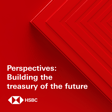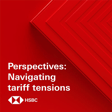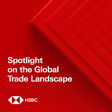Introduction to Global Banking and Market Trends
00:00:01
Speaker
This is HSBC Global Viewpoint, your window into the thinking, trends and issues shaping global banking and markets.
00:00:10
Speaker
Join us as we hear from industry leaders and HSBC experts on the latest insights and opportunities for your business.
00:00:18
Speaker
A heads up to our listeners that this episode has been recorded remotely, therefore the sound quality may vary.
00:00:25
Speaker
Thank you for listening.
00:00:30
Speaker
Thank you so much for joining us.
Key Figures in Automotive and Finance
00:00:32
Speaker
I'm Sarah Stockdale and today I'm joined from Toronto by Todd Shepelman, President and CEO of ABC Technologies, one of the world's leading automotive systems and components manufacturers.
00:00:43
Speaker
And from New York, Prima Vada Singh, Head of Product and Propositions, Global Trade and Receivables Finance, North America for HSBC Bank USA.
00:00:51
Speaker
Thank you both so much for being here today.
Recovery in the Americas: Challenges and Opportunities
00:00:54
Speaker
Our topic for today is recovery across the Americas, trade supply chains and new opportunities.
00:01:00
Speaker
USMCA entered into force last July and the Biden administration has now been in office for more than 100 days, feels like longer.
00:01:08
Speaker
Layering into that is the additional challenges that we have been experiencing as we've navigated through COVID-19.
00:01:15
Speaker
And it's changed how we live and work and impacted how business is conducted.
00:01:19
Speaker
With supply chain disruption becoming more commonplace, many firms are reviewing and reshaping their supply chains to build resilience.
00:01:26
Speaker
According to our 2020 Navigator survey findings, companies view these disruptions as the biggest internal factors hindering their growth.
00:01:35
Speaker
More than nine in 10 have concerns related to their supply chain.
00:01:39
Speaker
These concerns are consistent across industries.
00:01:41
Speaker
In response, businesses are making changes to how they select suppliers and manage their supply chain.
Supply Chain Resilience and Reshoring Trends
00:01:47
Speaker
With two leading voices on the topic in North America joining us, let's get straight into the discussion.
00:01:52
Speaker
Priyamvada, welcome.
00:01:54
Speaker
As we know, COVID has affected many things, including supply chains and trade.
00:01:59
Speaker
This has persisted, especially considering the recent third wave outbreak in India.
00:02:04
Speaker
How have America's managed through the crisis and throughout their supply chain in the region and globally?
00:02:09
Speaker
What the pandemic has done has led to a fundamental rethinking of the utility of offshore supply chains to some extent.
00:02:15
Speaker
and corporates across the region, and we'll be hearing from Todd soon as well, that if they haven't already, they have been prioritizing holistic reviews of sourcing practices to better manage hotspots and vulnerabilities.
00:02:26
Speaker
And that's likely to accelerate trends and some level of reshoring to ensure business continuity.
00:02:31
Speaker
It may lead perhaps in the short term to more inventory being held in stockpile to keep production lines going because we've seen other disruptions as well.
Impact of Global Events on Supply Chains
00:02:39
Speaker
For example, the Suez Canal blockade or now the shortage of shipping containers, rising freight rates, and even cyber attacks like the ransomware incidents we've seen.
00:02:48
Speaker
So the risk assessments of these supply chains is understandably complex because the more global a supply chain, it's often been built on specialization and concentration in sourcing.
00:02:58
Speaker
That can be hard to replicate or shift quickly.
00:03:01
Speaker
So we've seen corporates accelerating a diversification of their supplier base, which is an obvious step towards building more resilience.
00:03:08
Speaker
And it's likely to be accelerated because of events of the past year.
00:03:12
Speaker
Even today, actually, I think it's important to note the supply chain shortages that continue to exist in manufacturing, lumber, chips, semiconductors, and that's slowing production for everything from computers to home appliances and automobiles.
00:03:26
Speaker
So there have been greater investments in nearshoring production.
00:03:29
Speaker
So that's another strategy that companies are adopting.
U.S. Policy on Supply Chain Resilience
00:03:32
Speaker
Now, it does remain debatable whether there'll be greater adoption of more regionalized model of supply.
00:03:37
Speaker
The question really is whether any sourcing strategy with onshore or offshore concentration could potentially offset benefits of diversification.
00:03:46
Speaker
Lastly, I want to also, as you're aware, the U.S. government released in February of this year the Executive Order on America supply chain.
00:03:53
Speaker
That was a 100-day plan to address the need for building more resilient, diverse, and secure supply chains.
00:03:59
Speaker
Yesterday, the administration announced key findings from that report and actions to address vulnerabilities.
00:04:05
Speaker
And that actually did include specifically four key supply chains, which was around critical medicines, advanced batteries, critical minerals, and semiconductors.
00:04:14
Speaker
And those actions also include options such as building capacity domestically and working internationally with partners.
00:04:21
Speaker
Now, international expansion may well have some challenges where government policies in other countries become more trade restrictive.
00:04:29
Speaker
to cope with domestic recovery on their own.
00:04:31
Speaker
Ultimately though, what we believe has emerged more strongly is the recognition that companies prioritize supply chain resiliency.
00:04:38
Speaker
And terms like resiliency and transparency have become resoundingly popular.
00:04:43
Speaker
We believe companies will continue to drive that deeper understanding of their supply chain to address precisely those vulnerabilities because the pandemic has brought these supply chain issues to the forefront.
00:04:56
Speaker
And thank you so much, Priyamvada.
00:04:59
Speaker
I'd like to bring in Todd.
ABC Technologies' COVID-19 Response
00:05:01
Speaker
As president and CEO of ABC Technologies, which manufactures auto parts in factories across Canada, the US, Mexico, as well as in Europe, South America, and parts of China, you've experienced firsthand the impacts over the last 12 months.
00:05:15
Speaker
What have those 12 months brought for the company?
00:05:18
Speaker
And do the comments shared by Priyamvada reflect your reality?
00:05:22
Speaker
When COVID hit the automotive space,
00:05:25
Speaker
there's really no playbook on how to react to this.
00:05:27
Speaker
So we really sprang into action and our first priority certainly was safety of our employees.
00:05:32
Speaker
So we created our own action plans on how to get back to work, how to operate safely, do social distancing in both plants and office environments.
00:05:39
Speaker
And then almost immediately we were contacted by both our customers and governments about pivoting the supply medical devices.
00:05:46
Speaker
And really within just a couple of weeks, we went from a full production of auto parts to complete shutdown,
00:05:52
Speaker
to designing building tools and assembly equipment so that we can produce ventilator parts, face shields, and face masks so that we could help in our support of the frontline workers and really society in general on this.
00:06:05
Speaker
Back in the May timeframe, June timeframe, we went back into high volume automotive production and things were going pretty well.
00:06:11
Speaker
And then recently, we started hearing, it was probably late November, early December about this semiconductor shortage.
00:06:18
Speaker
And I don't think anybody really understood what that was when we first started hearing about it.
00:06:22
Speaker
And certainly that has been now an impact in the automotive space.
00:06:27
Speaker
But for automotive, we really see that just the semiconductors alone have the potential to impact up to 1.5 million units just in North America production.
00:06:36
Speaker
And while that will be made up, it's certainly been pushed out.
00:06:39
Speaker
But there's also steel, resin, rubber, foam, and many other materials that have been impacted during this.
00:06:45
Speaker
There was a recent article that was published by Alex Partners and talking about just the raw material baskets within a car.
00:06:55
Speaker
And year over year, those raw materials increased over 90% to about $3,600 from $1,900.
00:07:01
Speaker
That's a huge change.
00:07:03
Speaker
And while steel was the major driver of that, our main input is plastics into my business.
00:07:10
Speaker
And plastics had gone up over 150% year over year.
00:07:14
Speaker
So while we can mitigate some of these and really the industry can mitigate some of these through hedging strategies or direct buy programs, material adjustments or regular commercial negotiations, it's really difficult for the supply base to really mitigate the whole thing.
00:07:30
Speaker
While leaders and people in the business can't really choose the timeframe at which they lead, they can certainly choose how they lead.
Enhancing Supply Chain Visibility and Management
00:07:37
Speaker
And so I think I'm very proud of the whole team on what we've done and
00:07:41
Speaker
How have you built more resilience into your supply chain through this?
00:07:46
Speaker
We've really been driving more visibility back into our supply chain, both the tier two suppliers and the tier three suppliers.
00:07:52
Speaker
And initially it was really driven by COVID protocols, making sure that they could operate.
00:07:58
Speaker
But more recently, it's been around financial health.
00:08:00
Speaker
Do they have enough labor availability?
00:08:02
Speaker
What's their supply chains like?
00:08:03
Speaker
So we've been spending a lot more time on that for sure.
00:08:07
Speaker
We're also carrying more inventory costs of our primary raw material and purchase component inputs.
00:08:13
Speaker
And a lot of that's based on availability, but there's also been a tremendous issue with shipping, particularly overseas.
00:08:20
Speaker
We've got that we had to lengthen our anticipated booking dates as well as transit times across the ocean.
00:08:26
Speaker
There's been port congestion that's been caused by COVID and ships backing up that basically doubled the time for ocean transport.
00:08:34
Speaker
We've seen the lack of shipping containers
00:08:36
Speaker
And all this has really driven a lot of people to air freight.
00:08:39
Speaker
So, you know, even when you have to air freight in an emergency, there's no planes available.
00:08:43
Speaker
And sometimes they were booking up to eight weeks out for air freight out of Asia.
00:08:47
Speaker
So it's really been crazy.
00:08:49
Speaker
So one of the things that we've been really trying to do is looking at supply alternatives and contingencies in our key input materials ahead of time to make sure that when it does hit, we've done the hard work.
00:09:01
Speaker
ahead of time to make sure that we're available for it.
00:09:03
Speaker
And it does take a lot of extra effort, but I think it's certainly worth the work.
00:09:09
Speaker
But it really, I think it just focused, we really need to rethink where we're at on supply chains and really have additional flexibility to shorten these supply lines.
00:09:19
Speaker
And COVID's really shown us that these supply chains are much more fragile than we had anticipated.
00:09:25
Speaker
And I think the status quo likely needs to be refreshed or reshaped or even in some cases reinvented as we go forward to protect on this.
00:09:33
Speaker
Prima Vada, I want to come to you.
Diversification and Transparency in North American Supply Chains
00:09:35
Speaker
What are we seeing from a broader North American company standpoint in their supply chains?
00:09:40
Speaker
Are there any key trends that we should be watching for?
00:09:43
Speaker
Given how complex global supply chains have become, the disruptive events of last year certainly highlighted the dangers of having opaque or highly concentrated sources of supply because they become vulnerable in times of stress.
00:09:57
Speaker
And diversification of sources, they consciously reduce dependence on supply from the lowest cost markets to identify alternative sources from a wider range.
00:10:06
Speaker
Now, that was already evident over the past few years, not just because of the pandemic, but because of the protectionist policies, right?
00:10:13
Speaker
the trade tensions amongst trading partners.
00:10:15
Speaker
Now, in parallel, the move towards adopting regional strategies or near-shoring such that a notable proportion of key goods is produced within the region in which they're consumed will also provide the opportunity for more control and stability in sourcing.
00:10:29
Speaker
Companies in North America might well be expanding more sourcing locations from Mexico, Central America, for example.
00:10:36
Speaker
Now, beyond that, there's also greater appreciation for supply chain transparency.
00:10:41
Speaker
The multi-tier supply chain that Todd referred to is exactly the challenge that companies face in mapping a transparent supply chain.
00:10:50
Speaker
Understanding a multi-tier supply chain can be challenging because it requires mapping out buyers and suppliers down to the first mile producer.
00:10:58
Speaker
because only then you can anticipate potential sources of disruption because it's necessary often down to an individual component level.
00:11:05
Speaker
And this is an extensive exercise.
00:11:08
Speaker
So not every supply chain can lend itself easily to such discoveries.
00:11:12
Speaker
So the quantum of that problem shouldn't be underestimated, clearly.
00:11:16
Speaker
Recent McKinsey study reported that over 50 percent of supply chain executives that they surveyed across over 20 different industries said that they had no clear visibility beyond their first-year suppliers.
00:11:28
Speaker
So the challenge is worth considering for a number of companies wanting to create more transparency and more control.
00:11:38
Speaker
Now, in all of these shifting patterns of supply chain management, one key development has been how new technologies can change the economics of resilience.
Technological Shifts in Supply Chain Economics
00:11:47
Speaker
The automation of processes to reduce input costs is an obvious one, but perhaps even allow workforce productivity to be maintained in the event of closures is an example that could be deployed for the future.
00:12:00
Speaker
The studies that have been published on changing business models have also shown the shift in mindset from just-in-time to just-in-case.
00:12:09
Speaker
That's been off-quoted.
00:12:10
Speaker
Now, moving away from just-in-time doesn't necessarily equate always to reduction in cost efficiency or ballooning inventory, as was traditionally thought, because digital tools today can provide the ability to monitor, connect, and collaborate across their supply chains.
00:12:25
Speaker
especially providing deeper visibility into multi-tier supply chains.
00:12:29
Speaker
So better supply chain management has certainly risen to the forefront and that's likely to continue for companies building for the future.
00:12:36
Speaker
Last year, there was a paper published also by IDC which published the results of a survey that 60% of companies expected their businesses to be disrupted over the next three years by a competitor with better supply chain capabilities.
00:12:52
Speaker
not a new product, not even a new business model, just better supply chain management.
00:12:57
Speaker
So I would say the opportunity is now for building better supply chain management capabilities and trends have intensified for companies to deploy strategies for resilient supply chain and increase visibility, whether it's potential diversification of sourcing of supply or greater adoption of technology.
00:13:16
Speaker
And all of these are trends we're likely to see well beyond 2021.
00:13:22
Speaker
And I think what you said there about if you are not building in this flexibility and if you're not thinking end to end and really breaking down that experience, every single component piece, knowing exactly end to end, having that transparency, a competitor is going to come in and do that.
00:13:43
Speaker
competitor is going to come in with the exact same product and be able to deliver even in turbulent times, even when there are challenges and disruptions that couldn't be necessarily predicted, but with that greater transparency and flexibility can be managed.
EV Transition and Supply Chain Impacts
00:13:57
Speaker
Todd, I would like to go to you because the car industry is undergoing a massive transformation by pivoting quickly to electric vehicles in order to become more sustainable.
00:14:07
Speaker
And that is obviously going to have a huge and a massive impact on your supply chain.
00:14:13
Speaker
How are you moving along on the transition to building in more sustainable products?
00:14:19
Speaker
I think we're in a much better position than many in the auto space.
00:14:23
Speaker
Our portfolio products is really 90 percent power train agnostic, meaning that we're ready today and we're already selling actively into this marketplace and making some good inroads there.
00:14:34
Speaker
So light weighting has really been the core competency of ABC over several decades.
00:14:39
Speaker
And as we transition into electric vehicle, it's going to be even more important as customer range anxiety is a huge issue in this transition.
00:14:48
Speaker
Most people don't think about the 99% of the time that they drive 22 kilometers to work and back.
00:14:53
Speaker
If they think about that one time where they have to drive 400 miles to their grandparents' house during the holidays and will their electric vehicle make it in the snow.
00:15:02
Speaker
Lower mass really translates into more range and less need for batteries on the vehicle, which is really more cost effective for the OEMs.
00:15:10
Speaker
And so we really think this is a tremendous tailwind for us.
00:15:13
Speaker
But at the same time, people are going to continue to drive internal combustion engines for
00:15:19
Speaker
They're not going away overnight, despite some of the reports you might see on the media.
00:15:25
Speaker
So we really think that this is a market that we've really been satisfying for a long period of time.
00:15:30
Speaker
But also there's changes happening here.
00:15:32
Speaker
When we see a lot of the governments around the world are really focused on climate initiatives, and that's really going to drive more stringent fuel economy and emission requirements.
00:15:41
Speaker
which will require lower mass to get better fuel economy on these vehicles.
00:15:45
Speaker
And then some of the requirements that we're seeing are up to 50% more fuel economy requirements coming at us in very quick time periods.
00:15:51
Speaker
So whether it's EV or internal combustion engines, we're ready for both of them today.
00:15:57
Speaker
But I think there's a lesser known opportunity out there as we look at EVs to really reimagine the vehicle and the space.
00:16:05
Speaker
There's no engine, there's no transmission, no driveline, no exhaust, no fuel system.
00:16:10
Speaker
I think this gives us a really good opportunity to reimagine the environment of the entire vehicle.
00:16:14
Speaker
And one of the areas we're focusing on is the consumer experience with their vehicle and how to provide more functionality on the interior.
00:16:22
Speaker
People are using their cars much more for work.
00:16:24
Speaker
They want places for their laptops and their bags and their backpacks and a tray that slides out that's convenient for them.
00:16:30
Speaker
I know all of us balance our laptops on our knee while we're not supposed to be doing that.
00:16:35
Speaker
We're just trying to reinvent how that's done.
00:16:38
Speaker
But we're also looking at more storage options and customer convenience to improve utility.
00:16:43
Speaker
A lot of OEMs on some of their more recent vehicles have introduced the frunk, which is the front trunk where the engine used to go.
00:16:50
Speaker
But it's really just a big open space right now that's not very, it doesn't provide a lot of utility.
00:16:55
Speaker
And so we're trying to just reimagine that and spend a lot of time on that.
00:16:59
Speaker
But you're also seeing a transition of now established OEMs coming into the marketplace with a much more robust portfolio of products.
00:17:06
Speaker
And then it's really now focused on crossovers, SUVs, and pickup trucks where the first entrance were primarily small urban vehicles or passenger cars.
00:17:14
Speaker
But when that happens, you know that we're heading into this era going forward.
00:17:20
Speaker
And when they launch these vehicles that have so much spotlight on them and it's so important to the companies,
00:17:26
Speaker
they're really looking at, you know, who do I trust and who has, who's a proven partner in the supply base to help me launch these vehicles.
00:17:33
Speaker
And so we've got a lot of longstanding relationships in these spaces with major OEM.
00:17:37
Speaker
So I think that's a really a good strong tailwind for us too, but there's also an increasing number of new entrants into the EV space.
00:17:45
Speaker
And this is opening up a lot of opportunities for new relationships and opportunity for us.
00:17:50
Speaker
And, but we really just think that our capabilities are focused on pushing the leading edge of innovation on vehicles,
00:17:56
Speaker
And whether it's current generation of CUV SUV and pickup trucks or the transition that we're making right now into the EV space, we're positioned right now very well.
00:18:05
Speaker
So we're extremely excited about this transition right now.
00:18:09
Speaker
Todd, what are you seeing in terms of employee, supplier, consumer demand for producing environmentally responsible car parts?
00:18:15
Speaker
Are there any barriers or challenges to this either internally at ABC or with your external partners addressing these changing sustainability needs?
ABC’s ESG Initiatives and Sustainable Growth
00:18:25
Speaker
Yeah, I certainly think that the ESG expectations from all of our constituents are increasing and it doesn't matter whether it's our customers, our shareholders, potential investors, our employees.
00:18:36
Speaker
And we really view this as an overall positive to the business.
00:18:39
Speaker
As we look at some of the things that we're doing right now in this area, I'll just start with materials.
00:18:43
Speaker
And we're working with eco-friendly biopolymers that incorporate wood pulp from sustainable foresting practices.
00:18:51
Speaker
into the product and actually utilize less energy to transform them into the products.
00:18:56
Speaker
We're looking at recycled materials like carbon fiber, as well as added even 3D manufacturing opportunities.
00:19:03
Speaker
On the process side, we're doing an awful lot to reduce our environmental footprint on how we can drive new processes into our operations.
00:19:10
Speaker
And we've got three that we're involved with right now that we're pushing in that reduce our energy consumption by up to 20% while we're making the lightweight parts that I talked about earlier.
00:19:21
Speaker
And as I look at employees on the ESG side also, that's always been a real focus for us and the number one consideration of what we do in this business.
00:19:30
Speaker
And we've got the industry leading levels of workplace safety and it's something that's very important to us and we will continue to drive.
00:19:36
Speaker
I'm going forward.
00:19:37
Speaker
So overall, I don't see this as a barrier moving forward with it with ESG and the sustainability.
00:19:44
Speaker
And like a lot of companies out there, we're moving as fast as we can to drive the business to be more sustainable.
00:19:50
Speaker
We're just about ready to publish our third annual white paper on ESG to talk about some of the things that we're focused on.
00:19:56
Speaker
track what we've been doing that we said we were going to do and just really track our progress overall.
00:20:01
Speaker
So we really believe that ABC is well positioned for this now and in the future to be a leader in this area.
00:20:07
Speaker
And we think it's a net positive for us overall.
00:20:10
Speaker
You've had a big year.
00:20:13
Speaker
This has been an incredible year of change for ABC.
00:20:16
Speaker
With the company publicly trading since February, what are you looking forward to the most in the year ahead, Todd?
00:20:22
Speaker
our teams are really looking forward to a more unconstrained marketplace that isn't held back by materials.
00:20:30
Speaker
And, you know, it's really, we've been trying to drive improvements, but it's been like being a stock car driver in a NASCAR race over the last couple of years is that we have yellow flags every other lap and it's hard to keep up to the momentum here.
00:20:44
Speaker
And it's not a lot of fun to watch or participate in either, but,
00:20:47
Speaker
We really think that on the positive side that the consumer demand in the marketplace right now is exceptionally strong.
00:20:53
Speaker
I think last month SAR for sales was about 18.5 million on an annualized basis.
00:20:58
Speaker
But at the same time, dealer inventories are at all-time lows at 23 days.
00:21:02
Speaker
And in some cases, pickup trucks are down in the single digits where typically they want to be up in the 80-90 range and overall vehicles want to be at 50 or 60 to 70.
00:21:13
Speaker
We know that the OEMs are just going to go to full max out production as soon as they have full unconstrained material capabilities.
00:21:20
Speaker
And that just really bodes well for ABC as well as the whole industry to really drive forward in multiple quarters ahead of us to make up this demand shortage that's out there.
00:21:30
Speaker
So we're looking forward to that for sure.
00:21:33
Speaker
We've had an exceptionally strong year from an organic growth standpoint.
00:21:36
Speaker
We think that there's tremendous opportunities in front of us to do
00:21:40
Speaker
some acquisitive growth in the marketplace.
00:21:42
Speaker
Our industry is pretty fragmented and we have the ability to look at consolidation.
00:21:47
Speaker
I think these are all really solid opportunities for us to grow, better serve our OEMs and also our shareholders.
00:21:53
Speaker
And going back to you, Prima Vada, what are you looking forward to the most across the Americas in 2021 and beyond?
Finance and Technology for Sustainable Supply Chains
00:22:01
Speaker
A couple of trends, notable trends, and I think Todd has mentioned one key one that we're definitely, as a bank, keenly supporting, which is around sustainability.
00:22:10
Speaker
So certainly the challenges around addressing climate change with our solutions.
00:22:16
Speaker
As I spoke about refining procurement strategy previously, that companies are looking to do this better supply chain management and effectively leveraging technology for better transparency and visibility.
00:22:26
Speaker
also goes to the heart of actually to be able to be more sustainable.
00:22:31
Speaker
Now, the pressure to be sustainable is on companies, whether it's because it's not just because of activist strategies to pressure corporate boardrooms, but it's in general a realization for companies, governments, or even cities that this is the need of the hour.
00:22:45
Speaker
And perhaps whether it's coming off of the pandemic, this chance to rebuild and reshape the global economy and the environment that companies are operating in after the pandemic
00:22:55
Speaker
It's making investors and companies and governments look far more closely at the longer term impact of the dollars that they're spending today, because there is a realization of the deep impact that rapid climate change could be very, very expensive in the future, unless something is done about it now.
00:23:12
Speaker
So greater supply chain transparency, we believe, will actually naturally complement greater control over driving sustainability in supply chains and looking at more efficient sourcing and circularity and end use of product.
00:23:26
Speaker
Acceleration towards sustainability is also recognition by companies, as Todd has already mentioned, that it's beyond just enhancing company reputation and shareholder value.
00:23:36
Speaker
It's also making economic sense to do so.
00:23:39
Speaker
The call to banking and financial services is how do we support our clients with solutions around sustainability?
00:23:46
Speaker
We're frequently engaged by clients to provide such solutions around working capital.
00:23:51
Speaker
And we've been able to structure working capital programs that directly influence greater sustainability by using financial incentives.
00:23:58
Speaker
We've supported trained supply chain with greater digitization activities and the advent of technology that I spoke about earlier, which is the other key trend that's going to transform supply chains.
00:24:08
Speaker
That all of the partners in supply chains will need to adopt more technological tools.
00:24:15
Speaker
We believe as digitization of the trade supply chain accelerates, platforms and providers that service trade will have to keep pace, which is logistics, insurance, and financial services.
00:24:27
Speaker
So if new technologies allow interoperability of these platforms, that connectivity has the ability to release unparalleled big data.
00:24:37
Speaker
That opportunity, the ability to leverage that data and build better solutions will ultimately determine whether
00:24:43
Speaker
we survive and succeed in the future.
00:24:46
Speaker
We are committed to finding solutions, leveraging technology to support our clients, whether it's for greater supply chain resiliency or certainly sourcing sustainability, and that really is the future.
00:24:56
Speaker
It aligns with our clients' long-term goals.
00:24:58
Speaker
So we believe in also from a corporate transition from total shareholder value to total societal value.
00:25:06
Speaker
So I think at this point, we seem to be poised at a very
00:25:10
Speaker
pivotal moment in history where the future is being defined by technological advances for changing business models of companies and sustainable businesses and sustainable supply chains will be the future.
00:25:22
Speaker
That's something to look forward to.
00:25:24
Speaker
It's a huge thing to look forward to, especially what you talked about moving from
00:25:29
Speaker
shareholder value to societal
Reflections on Societal Values and Future Outlook
00:25:31
Speaker
I think that's a great place to end off at, but I wanted to thank you both Todd and Priyavada for joining us today.
00:25:39
Speaker
We will have another conversation again.
00:25:42
Speaker
And until next time, thank you so much for all being here.
00:25:46
Speaker
Have a wonderful rest of your day, everyone.
00:25:48
Speaker
Thank you for listening today.
00:25:51
Speaker
This has been HSBC Global Viewpoint, Banking and Markets.
00:25:55
Speaker
For more information about anything you heard in this podcast,
00:25:58
Speaker
or to learn about HSBC's global services and offerings, please visit gbm.hsbc.com.


















